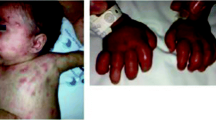Abstract
Three siblings with recalcitrant leg ulceration, splenomegaly, photosensitive rash, and autoantibodies were suspected of having prolidase deficiency. Urine was checked for iminodipeptiduria, fibroblasts were cultured and analyzed for prolidase activity, and DNA was extracted for identifying the causative mutation. Glycyl proline was found as the dominant dipeptide in the urine. The activity of proline dipeptidase in fibroblasts was 2.5% of control fibroblasts. Sequence analysis of the PEPD gene revealed a homozygous nonsense C→G transition at nucleotide 768. In conclusion, prolidase deficiency was diagnosed in siblings with skin ulceration autoantibodies and a lupus-like disease. A novel nonsense mutation was found, associated with the severe outcome of our patients.





Similar content being viewed by others
References
Beck B, Christensen E, Brandt NJ (1981) Forminoglutamic aciduria in a slightly retarded boy with chronic obstructive lung disease. J Inher Metabol Dis 4:225–228
Ben-Bassat H, Eldad A, Chaouat M et al (1992) Structural and functional evaluation of modifications in the composite skin graft: cryopreserved dermis and cultured keratinocytes. Plast Reconstr Surg 89:510–520
Bissonete R, Friedmann D, Giroux JM et al (1993) Prolidase deficiency: a multisystemic hereditary disorder. J Am Acad Dermatol 29:818–821
Chen KR, Carlson JA (2008) Clinical approach to cutaneous vasculitis. Am J Clin Dermatol 9:71–92
Christensen E (1983) Improved assay of glutaryl-CoA dehydrogenase in cultured cells and liver: application to glutaric aciduria type I. Clin Chim Acta 129:91–97
Di Rocco M, Fanmtasia AR, Taro M et al (2007) Systemic lupus erythematosus-like disease in a 6-year-old boy with prolidase deficiency. J Inherit Metab Dis 30:814
Falik-Zaccai TC, Khayat M, Luder A et al (Mar 23 2009) A broad spectrum of developmental delay in a large cohort of prolidase deficiency patients demonstrates marked interfamilial and intrafamilial phenotypic variability. Am J Med Genet B Neuropsychiatr Genet (in press)
Goodman SI, Solomons CC, Muschenheim F et al (1968) A syndrome resembling lathyrism associated with iminodipeptiduria. Am J Med 45:152–159
Hershkovitz T, Hassoun G, Indelman M et al (2006) A homozygous missense mutation in PEPD encoding peptidase D causes prolidase deficiency associated with hyper-IgE syndrome. Clin Exp Dermatol 31:435–440
Jackson SH, Dennis AW, Greenberg M (1975) Iminodipeptiduria. A genetic defect in recycling collagen; a method for determining prolidase in erythrocytes. Can Med Assoc J 113:759–763
Jemec GB, Moe AT (1996) Topical treatment of skin ulcres in prolidase deficiency. Pediatr Dermatol 13:58–60
Johnstone RAW, Povall JT, Baty D (1974) Determination of dipeptides in urine. Clin Chim Acta 52:137–142
Kurien BT, Patel NC, Porter AC et al (2006) Prolidase deficiency and the biochemical assays used in its diagnosis. Anal Biochem 349:165–175
Lopes I, Marques L, Neves E et al (2002) Prolidase deficiency with hyperimmunoglobulin E: a case report. Pediatr Allergy Immunol 13:140–142
Lupi A, Rossi A, Campari E et al (2006) Molecular characterization of six patients with prolidase deficiency: identification of the first small duplication in the prolidase gene and of a mutation generating symptomatic and asymptomatic outcomes within the same family. J Med Genet 43:e58
Lupi A, Tenni R, Rossi A et al (2008) Human prolidase and prolidase deficiency: an overview on the characterization of the enzyme involved in proline recycling and on the effects of its mutations. Amino Acids 35:739–752
Maricq HR, Spencer-Green G, Leryo EC (1987) Skin capillary abnormalities as indicators of organ involvement in scleroderma (systemic sclerosis), Raynaud’s syndrome and dermatomyositis. Am J Med 61:862–870
Myara I, Charpentier C, Lemonnier (1987) Prolidase and prolidase deficiency. A mini review. Life Sci 34:1985–1998
Pedersen PS, Christensen E, Brandt NJ (1983) Prolidase deficiency. Acta Paediatr Scand 72:785
Powell GP, Rasco MA, Maniscalco RM (1974) A prolidase deficiency in man with iminopeptiduria. Metabolism 23:505–513
Sambrook J, Fritsch EF, Maniatis T (1989) Molecular cloning. A laboratory manual. Cold Spring Harbor Laboratory Press, New York
Sheffield LJ, Schlesinger P, Faull K et al (1997) Iminopeptiduria, skin ulceration, and edema in a boy with prolidase deficiency. J Pediatr 91:578–583
Shrinath M, Walter JH, Haeney M et al (1997) Prolidase deficiency and systemic lupus erythematosus. Arch Dis Child 76:441–444
Tan EM, Cohen AS, Fries JF et al (1982) The1982 revised criteria for the classification of systemic lupus erythematosus. Arthritis Rheum 25:1271–1277
Wang H, Kurien BT, Lundgrn D et al (2006) A nonsense mutation of PEPD in four Amish children with prolidase deficiency. Am J Med Genet A 140:580–585
Acknowledgments
We would like to thank N. Alon and L. Golan for their editorial assistance.
Conflict of Interest
The authors declare that they have no conflict of interest, financial or otherwise, in connection with the paper.
Author information
Authors and Affiliations
Corresponding author
Rights and permissions
About this article
Cite this article
Klar, A., Navon-Elkan, P., Rubinow, A. et al. Prolidase deficiency: it looks like systemic lupus erythematosus but it is not. Eur J Pediatr 169, 727–732 (2010). https://doi.org/10.1007/s00431-009-1102-1
Received:
Accepted:
Published:
Issue Date:
DOI: https://doi.org/10.1007/s00431-009-1102-1




